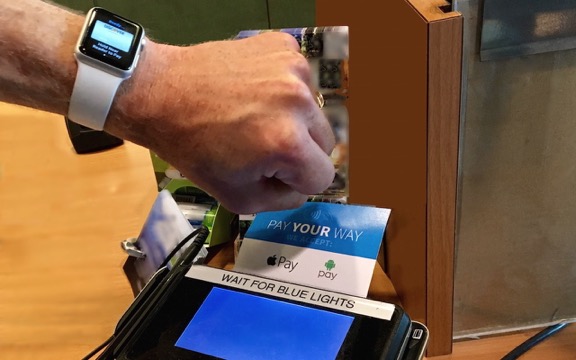Apple Pay: The easiest way to pay … everywhere
It’s only natural to feel reticent, even suspicious, when considering a technology such as Apple Pay®.
In theory, it feels nuts to cozy up to a payment terminal with your phone or watch to make your money disappear.
But Apple Pay and similar technologies that leverage information encryption are here to stay. That’s because Apple Pay is easy to use, preserves your privacy and enhances your financial security. It’s more secure than using a credit card — by far.
Apple Pay works with your iPhone®, iPad® and Apple Watch® and allows you to make secure purchases in stores, with apps and on the web. There’s no app to download, it’s easier than using a credit or debit card and faster than opening your wallet to do so. Simply hold your device within an inch of a compatible payment terminal — and they are virtually everywhere — put your finger on the Home button to use Touch ID® (or double-press the iPhone X’s side button and authenticate via Face ID® or double-press the Apple Watch’s side button), and you’re done. (Plus, Apple Pay Cash, launched with iOS 11.2, allows you to make and receive person-to-person payments in the Messages app or even by asking Siri. Wow.)
So how does this seemingly magical technology work?
When you pay with Apple Pay, the Secure Enclave chip transmits the Device A;rypted until it reaches the appropriate party, at which point your transaction is approved and processed.
Through it all, the process is significantly more secure than a magnetic-strip credit card and also has advantages over chip-embedded cards. First, theft prevention is baked in. A typical thief can’t use Apple Pay from your device because they can’t get past Touch ID or Face ID, or provide your Apple Watch passcode.
Also, the store where you shop collects no data from your payment process. They don’t know who you are, where you live, what your card number is or any other personal information — unless possibly you displayed a rewards card or provided your phone number. Bottom line, you don’t ever have to worry about your credit card number being jotted down, scanned or skimmed.
Millions of payment terminals in the United States accept Apple Pay, including those found in most major retail chains, so you shouldn’t have to look far to find one. You can also use Apple Pay in some iOS apps and some web-based shopping carts when checking out in Safari.
It’s easy to set up Apple Pay on your iPhone or iPad. Tap Settings > Wallet & Apple Pay > Add Credit or Debit Card and then follow the easy instructions. It’s fine to let the device scan your card so that you don’t have to type your credit card number, as the image is discarded immediately after setup.
After adding a card, find it in the Wallet app and tap the card’s info button at the lower right to explore the Info and Transactions screens. Notice that four digits from the card’s Digital Account Number appear on the Info screen. If you want to return an Apple Pay purchase, you’ll provide these digits to the merchant instead of sharing your credit card number.
If you're ready to leap into the future, get started with Apple Pay. It’s fast, easy, secure and more private than swiping your credit card. Ask anyone at CranstonIT about Apple Pay, as we all use it! Contact us today at 888-813-5558 or support@cranstonit.com.

